Page 284 of 362
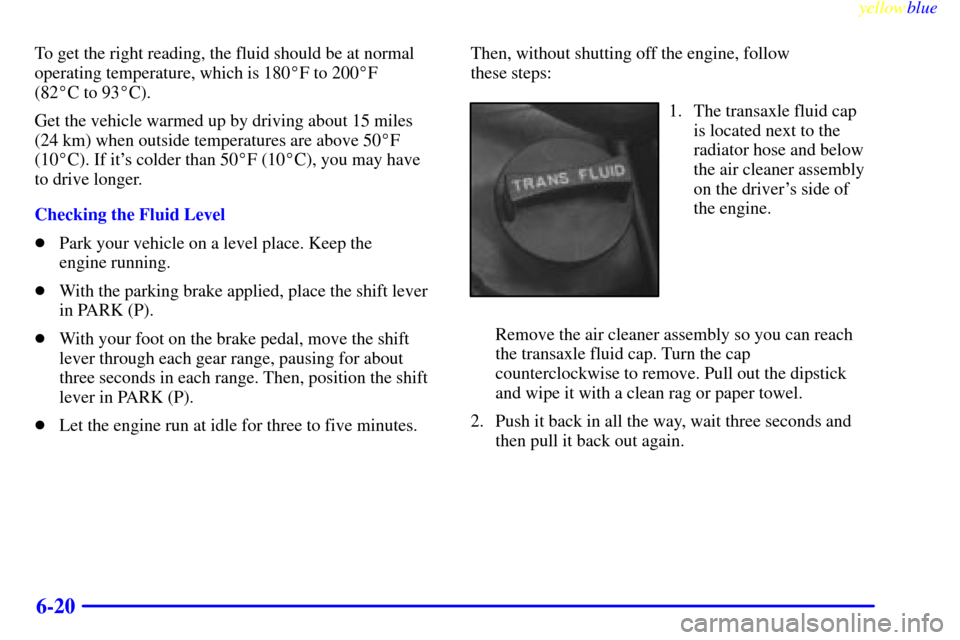
yellowblue
6-20
To get the right reading, the fluid should be at normal
operating temperature, which is 180�F to 200�F
(82�C to 93�C).
Get the vehicle warmed up by driving about 15 miles
(24 km) when outside temperatures are above 50�F
(10�C). If it's colder than 50�F (10�C), you may have
to drive longer.
Checking the Fluid Level
�Park your vehicle on a level place. Keep the
engine running.
�With the parking brake applied, place the shift lever
in PARK (P).
�With your foot on the brake pedal, move the shift
lever through each gear range, pausing for about
three seconds in each range. Then, position the shift
lever in PARK (P).
�Let the engine run at idle for three to five minutes.Then, without shutting off the engine, follow
these steps:
1. The transaxle fluid cap
is located next to the
radiator hose and below
the air cleaner assembly
on the driver's side of
the engine.
Remove the air cleaner assembly so you can reach
the transaxle fluid cap. Turn the cap
counterclockwise to remove. Pull out the dipstick
and wipe it with a clean rag or paper towel.
2. Push it back in all the way, wait three seconds and
then pull it back out again.
Page 286 of 362
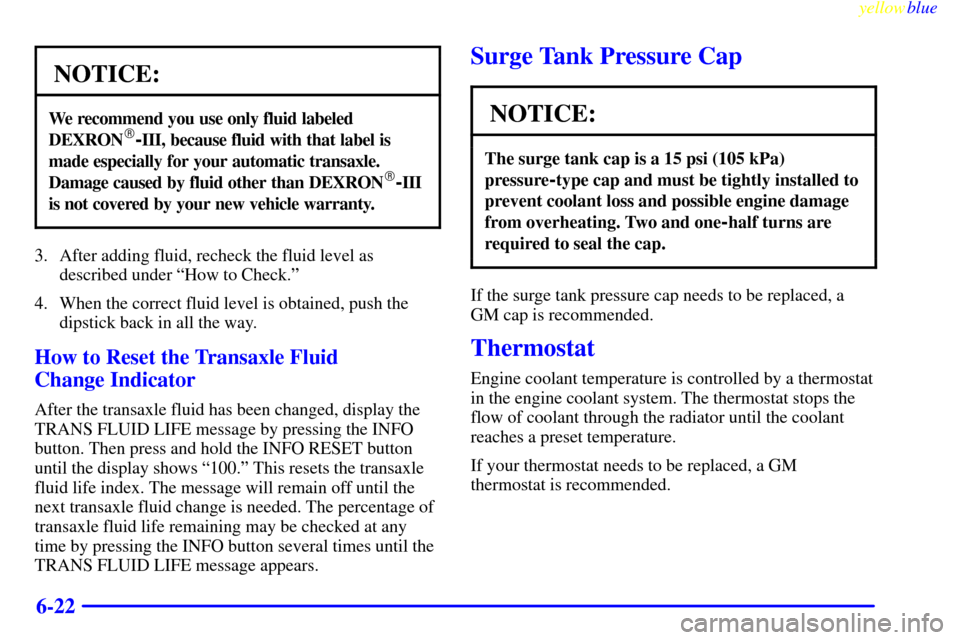
yellowblue
6-22
NOTICE:
We recommend you use only fluid labeled
DEXRON�-III, because fluid with that label is
made especially for your automatic transaxle.
Damage caused by fluid other than DEXRON
�-III
is not covered by your new vehicle warranty.
3. After adding fluid, recheck the fluid level as
described under ªHow to Check.º
4. When the correct fluid level is obtained, push the
dipstick back in all the way.
How to Reset the Transaxle Fluid
Change Indicator
After the transaxle fluid has been changed, display the
TRANS FLUID LIFE message by pressing the INFO
button. Then press and hold the INFO RESET button
until the display shows ª100.º This resets the transaxle
fluid life index. The message will remain off until the
next transaxle fluid change is needed. The percentage of
transaxle fluid life remaining may be checked at any
time by pressing the INFO button several times until the
TRANS FLUID LIFE message appears.
Surge Tank Pressure Cap
NOTICE:
The surge tank cap is a 15 psi (105 kPa)
pressure
-type cap and must be tightly installed to
prevent coolant loss and possible engine damage
from overheating. Two and one
-half turns are
required to seal the cap.
If the surge tank pressure cap needs to be replaced, a
GM cap is recommended.
Thermostat
Engine coolant temperature is controlled by a thermostat
in the engine coolant system. The thermostat stops the
flow of coolant through the radiator until the coolant
reaches a preset temperature.
If your thermostat needs to be replaced, a GM
thermostat is recommended.
Page 288 of 362
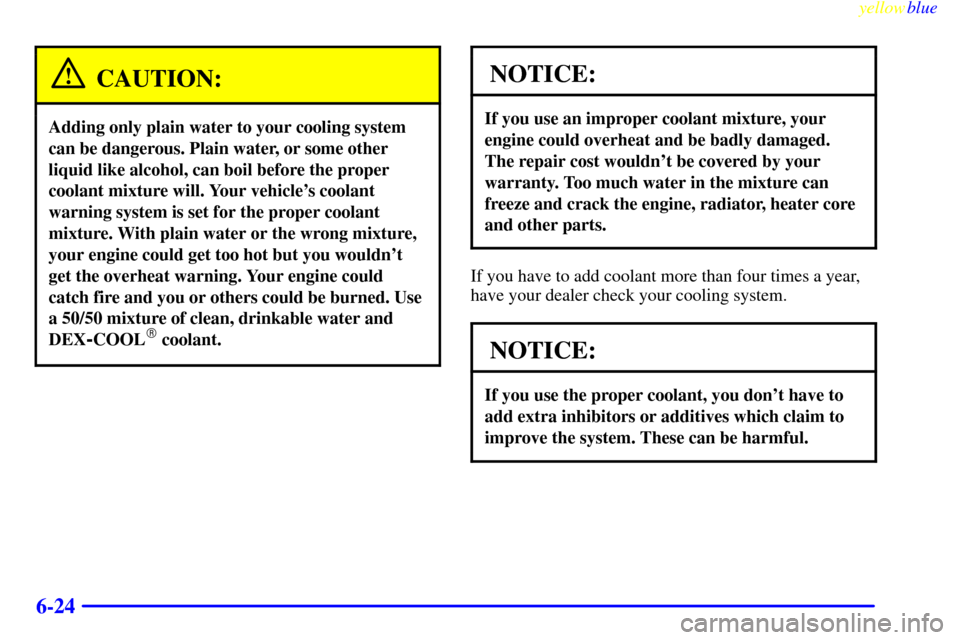
yellowblue
6-24
CAUTION:
Adding only plain water to your cooling system
can be dangerous. Plain water, or some other
liquid like alcohol, can boil before the proper
coolant mixture will. Your vehicle's coolant
warning system is set for the proper coolant
mixture. With plain water or the wrong mixture,
your engine could get too hot but you wouldn't
get the overheat warning. Your engine could
catch fire and you or others could be burned. Use
a 50/50 mixture of clean, drinkable water and
DEX
-COOL� coolant.
NOTICE:
If you use an improper coolant mixture, your
engine could overheat and be badly damaged.
The repair cost wouldn't be covered by your
warranty. Too much water in the mixture can
freeze and crack the engine, radiator, heater core
and other parts.
If you have to add coolant more than four times a year,
have your dealer check your cooling system.
NOTICE:
If you use the proper coolant, you don't have to
add extra inhibitors or additives which claim to
improve the system. These can be harmful.
Page 289 of 362
yellowblue
6-25 Checking Coolant
The engine coolant surge tank is located on the driver's
side of the engine.
The cooling system is under a lot of pressure when it is
hot. If the CHECK COOLANT LEVEL message
appears on the Driver Information Center, you will need
to add coolant.
CAUTION:
Turning the surge tank pressure cap when the
engine and radiator are hot can allow steam and
scalding liquids to blow out and burn you badly.
Never turn the surge tank pressure cap
-- even a
little
-- when the engine and radiator are hot.
The vehicle must be on a level surface. When your
engine is cold, the coolant level should be at the FULL
COLD mark, which is at or above the fill mark at the
edge of the surge tank.
If the CHECK COOLANT LEVEL message comes on
and stays on, it means you're low on engine coolant.
Page 290 of 362
yellowblue
6-26
Adding Coolant
If you need more coolant, add the proper DEX
-COOL�
coolant mixture at the surge tank, but only when the
engine is cool.
CAUTION:
You can be burned if you spill coolant on hot
engine parts. Coolant contains ethylene glycol,
and it will burn if the engine parts are hot
enough. Don't spill coolant on a hot engine.
When replacing the pressure cap, make sure it is
hand
-tight.
Power Steering Fluid
The power steering fluid
reservoir is located next to
the fuse relay center on the
passenger's side of
the engine.
When to Check Power Steering Fluid
It is not necessary to regularly check power steering
fluid unless you suspect there is a leak in the system or
you hear an unusual noise. A fluid loss in this system
could indicate a problem. Have the system inspected
and repaired.
Page 291 of 362
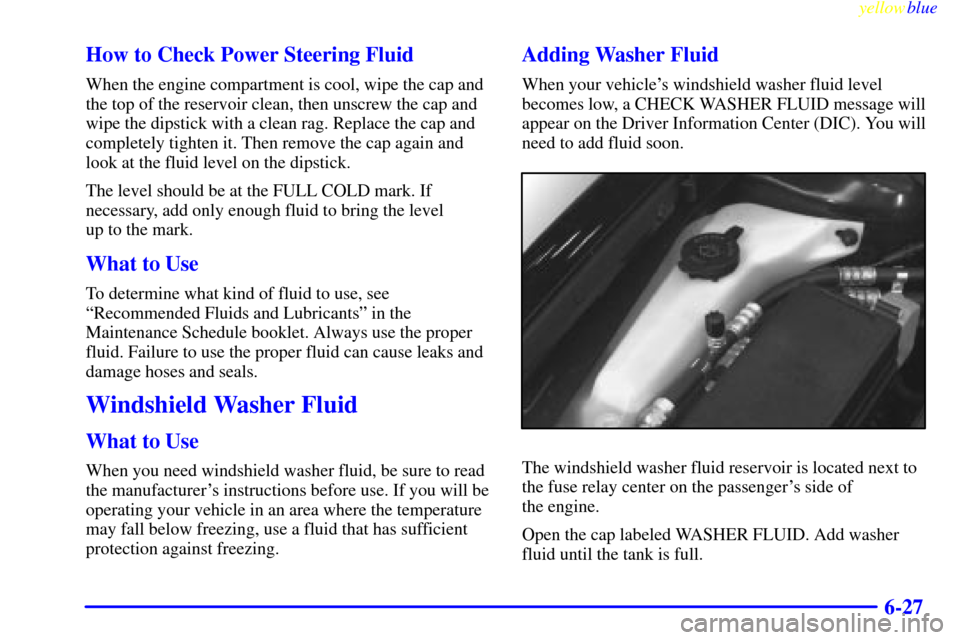
yellowblue
6-27 How to Check Power Steering Fluid
When the engine compartment is cool, wipe the cap and
the top of the reservoir clean, then unscrew the cap and
wipe the dipstick with a clean rag. Replace the cap and
completely tighten it. Then remove the cap again and
look at the fluid level on the dipstick.
The level should be at the FULL COLD mark. If
necessary, add only enough fluid to bring the level
up to the mark.
What to Use
To determine what kind of fluid to use, see
ªRecommended Fluids and Lubricantsº in the
Maintenance Schedule booklet. Always use the proper
fluid. Failure to use the proper fluid can cause leaks and
damage hoses and seals.
Windshield Washer Fluid
What to Use
When you need windshield washer fluid, be sure to read
the manufacturer's instructions before use. If you will be
operating your vehicle in an area where the temperature
may fall below freezing, use a fluid that has sufficient
protection against freezing.
Adding Washer Fluid
When your vehicle's windshield washer fluid level
becomes low, a CHECK WASHER FLUID message will
appear on the Driver Information Center (DIC). You will
need to add fluid soon.
The windshield washer fluid reservoir is located next to
the fuse relay center on the passenger's side of
the engine.
Open the cap labeled WASHER FLUID. Add washer
fluid until the tank is full.
Page 333 of 362

yellowblue
6-69 Wheel Nut Torque
100 lb-ft (140 N´m)
Capacities
Transaxle (4T80-E) 15.0 quarts (14.2 L). . . . . . . . . .
Crankcase (Engine Oil
with Filter Change) 7.5 quarts (7.1 L). . . . . . . . . .
Engine Cooling System 12.5 quarts (11.8 L). . . . . . .
Fuel Tank 18.5 gallons (70.7 L). . . . . . . . . . . . . . . . .
R
-134a Refrigerant 2.0 lbs. (0.91 kg). . . . . . . . . . . .
NOTE: All capacities are approximate. When adding, be
sure to fill to the approximate level, as recommended in
this manual. Recheck fluid level after filling.
Air Conditioning Refrigerants
Not all air conditioning refrigerants are the same.
If the air conditioning system in your vehicle needs
refrigerant, be sure the proper refrigerant is used.
If you're not sure, ask your dealer.
Normal Maintenance
Replacement Parts
Air Filter Element AC Type A1208C. . . . . . . . . . . . .
Fuel Filter Element AC Type GF
-627 . . . . . . . . . . . .
Engine Oil Filter AC Type PF
-58 . . . . . . . . . . . . . . . .
PCV Valve AC Type CV
-774C . . . . . . . . . . . . . . . . . .
Spark Plugs AC Type 41
-950 . . . . . . . . . . . . . . . . . . .
Thermostat AC Type 131
-66 . . . . . . . . . . . . . . . . . . . .
Windshield Wiper Blade
(Hook Type) 22 inches (56.5 cm). . . . . . . . . . . . . . .
Vehicle Dimensions
Wheel Base 112.2 inches (285.0 cm). . . . . . . . . . . . .
Length 201.0 inches (510.5 cm). . . . . . . . . . . . . . . . .
Height 55.4 inches (140.6 cm). . . . . . . . . . . . . . . . . . .
Width 75.0 inches (190.4 cm). . . . . . . . . . . . . . . . . . .
Front Tread 62.7 inches (159.3 cm). . . . . . . . . . . . . . .
Rear Tread 62.4 inches (158.6 cm). . . . . . . . . . . . . . .
Page 346 of 362
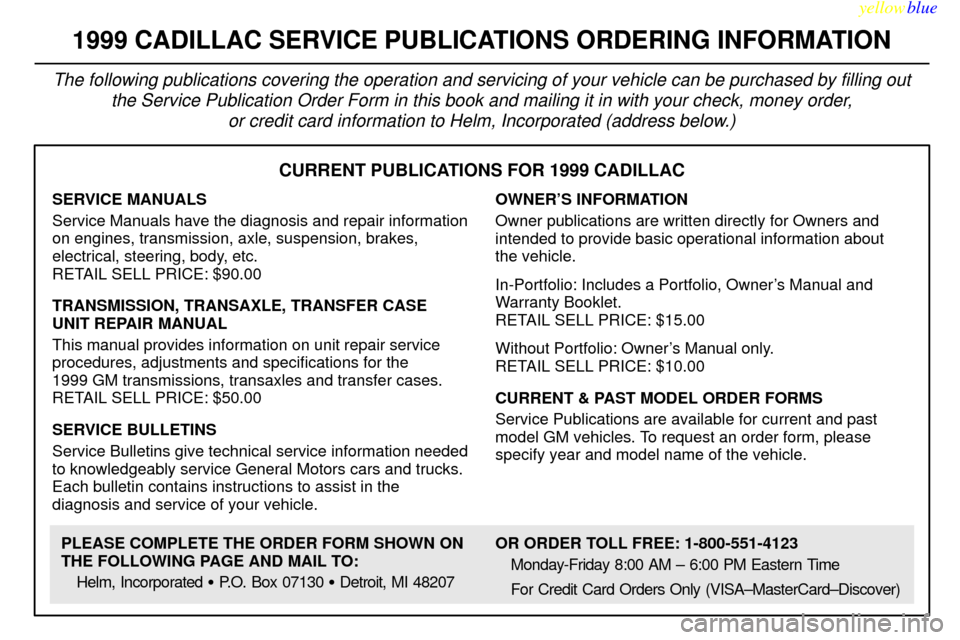
yellowblue
7-12
CURRENT PUBLICATIONS FOR 1999 CADILLAC
SERVICE MANUALS
Service Manuals have the diagnosis and repair information
on engines, transmission, axle, suspension, brakes,
electrical, steering, body, etc.
RETAIL SELL PRICE: $90.00
TRANSMISSION, TRANSAXLE, TRANSFER CASE
UNIT REPAIR MANUAL
This manual provides information on unit repair service
procedures, adjustments and specifications for the
1999 GM transmissions, transaxles and transfer cases.
RETAIL SELL PRICE: $50.00
SERVICE BULLETINS
Service Bulletins give technical service information needed
to knowledgeably service General Motors cars and trucks.
Each bulletin contains instructions to assist in the
diagnosis and service of your vehicle.OWNER'S INFORMATION
Owner publications are written directly for Owners and
intended to provide basic operational information about
the vehicle.
In-Portfolio: Includes a Portfolio, Owner's Manual and
Warranty Booklet.
RETAIL SELL PRICE: $15.00
Without Portfolio: Owner's Manual only.
RETAIL SELL PRICE: $10.00
CURRENT & PAST MODEL ORDER FORMS
Service Publications are available for current and past
model GM vehicles. To request an order form, please
specify year and model name of the vehicle.
PLEASE COMPLETE THE ORDER FORM SHOWN ON
THE FOLLOWING PAGE AND MAIL TO:
Helm, Incorporated � P.O. Box 07130 � Detroit, MI 48207OR ORDER TOLL FREE: 1-800-551-4123
Monday-Friday 8:00 AM ± 6:00 PM Eastern Time
For Credit Card Orders Only (VISA±MasterCard±Discover)
1999 CADILLAC SERVICE PUBLICATIONS ORDERING INFORMATION
The following publications covering the operation and servicing of your vehicle can be purchased by filling out
the Service Publication Order Form in this book and mailing it in with your check, money order,
or credit card information to Helm, Incorporated (address below.)